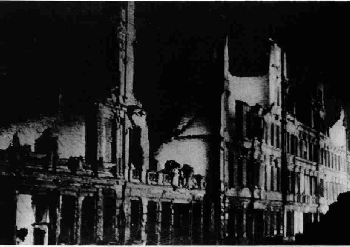

Post World War II Films
The nucleus of Germany's pre-war film industry fell within the Soviet occupation
zone. Soviet authorities quickly reopened, and by May 1945, thirty-six
Lichtspielhäuser were functioning in the Soviet zone of Berlin. The
British and American zones were comparitivley slow at getting the film industry
going again. While the Soviet zone played older, non-propogandistic films, the
allied zone adhered stictly to a policy of de-Nazification, making extensive
use of German motion pictures not associated with National Socialist propoganda.
In the name of democracy, both British and American authorities forbade combines
and seperated the functions of production, distribution, and exhibition. This
fragmentation of the German film industry actually served to prevent the
development of a serious competitor. German citizens were shown Welt im
Film (World on Film), the official Anglo-American newsreel, in an attempted
goal of "educating German public opinion on sound democratic lines."
Film policy in the American zone was guided by the Office of War Information
Overseas Motion Picture Bureau (OWI). During the spring of 1945, German films
were confiscated by the OWI in hopes of impressing upon the German people
their responsibility for the war. Short documentaries of concentration camps
were shown to German audiences during the first weeks of occupation. The OWI
regarded film as a tool for the reeducation of the Germans. These films lacked
entertainment value and were considered boring by most Germans. Germans were,
however, curious to see certain American films such as Gone With the Wind,
which had been censored during the Nazi era. But the film was not allowed in
Germany as it did not meet the objective of reeducation.
 The first post-war German production to recieve an American license was Und
über uns der Himmel (The Sky Above Us) directed by Josef von Baky. This
film portrayed Berlin as it was, with shots of the miles of rubble and the hardships
of its citizens. The more destroyed Germany appeared in a film, the more support
it received from OWI.
The first post-war German production to recieve an American license was Und
über uns der Himmel (The Sky Above Us) directed by Josef von Baky. This
film portrayed Berlin as it was, with shots of the miles of rubble and the hardships
of its citizens. The more destroyed Germany appeared in a film, the more support
it received from OWI.
Whether or not the OWI had succeeded in reeducating the Germans, it had
succeeded in subordinating the German industry to the U.S., giving the American
film a predominance in Germany which it exercises to this day. By 1948-49,
about 70% of the pictures exhibited in the American sector were of Hollywood
origin. The decade of the 1950's proved to be a time of crisis and transition
for the West German film industry. The industry was in dire financial trouble,
having lost its international market as well as a large share of its domestic market.
German banks refused to make loans to German production companies, so many were
forced to depend on private sponsors who were more concerned with making a
profit than the artistic value of films. German producers and directors were
reluctant to experiment with new techniques or themes. The German film appeared
to have reached an artistic dead end.
The 60s proved to be the darkest decade in the history of the postwar commercial
German cinema. In 1959 West Germany produced about 106 films, 98 in 1960, and
75 in 1961. Many production companies closed while survivors struggled to
maintain their share of the market, now seriously eroded by American competition
and the growth of television. The times were epitomized by the return of Fritz
Lang who had retired from the American film scence and chose to reenter the German
scene after an absence of more than a quarter of a century. He returned in 1958 to direct a new version of Das indische Grabmal.
Lang appears to have believed that the screenplay would be as valid in 1958
as it had been in 1920. Unfortunately, that was not the case as his movie
was not received well.
The German film seems to have bottomed out with the German western. Der Schatz
im Silbersee (The Treasure of Silver Lake) and Flusspriaten des
Mississippi (Mississippi Pirates) are two examples of films lacking
in originality. As one critic observed, "They look authentic enough; the
mountains, streams, plains and even the Red Indians are very familiar; but what
is lacking is imagination and style. Often the impression is that directors
have sat through many American films and then set out to copy them." It seemed
as though the German cinema had entered a downward spiral from which it could not escape.
Back to Homepage
The Formative Years
The Weimar Republic: The Golden Age of German Films
Third Reich Films
Emergence of the "New German Cinema"
Related Links
 The first post-war German production to recieve an American license was Und
über uns der Himmel (The Sky Above Us) directed by Josef von Baky. This
film portrayed Berlin as it was, with shots of the miles of rubble and the hardships
of its citizens. The more destroyed Germany appeared in a film, the more support
it received from OWI.
The first post-war German production to recieve an American license was Und
über uns der Himmel (The Sky Above Us) directed by Josef von Baky. This
film portrayed Berlin as it was, with shots of the miles of rubble and the hardships
of its citizens. The more destroyed Germany appeared in a film, the more support
it received from OWI.
